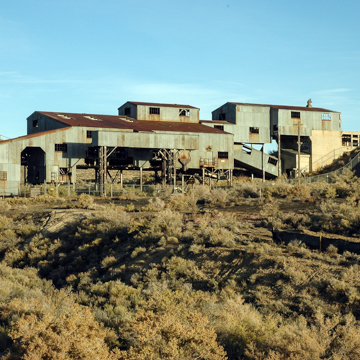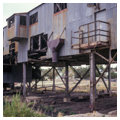The Reliance Tipple—a structure used to sort coal and load it into railroad cars—was opened in 1936 to much acclaim in the coal town of Reliance. Built as part of a modernization and improvement program by the Union Pacific Coal Company (U.P.C.C.), it replaced a more primitive wooden tipple dating from 1910, whose sandstone foundation is still standing east of the current structure.
The Reliance Tipple is constructed of steel and concrete with a series of openings on the east and west elevations and corrugated metal siding. From a distance, the tipple appears to be several structures built closely together. However, it is actually one long building with a variegated roofline, the result of its construction on a downgrade and the nature of the operations it housed. The structure was built above a rail bed to facilitate the unloading of coal from the mines, and the loading of sorted coal into railroad cars at the end of the process.
The interior of the tipple consists of two stories of steel and concrete rooms, stairways, and catwalks that once connected all the machinery and processes used in sorting coal. Coal was delivered to the tipple in railroad cars from the south end where a 6,700-foot-long motor line haulage system was installed from the mine to the tipple. At any one time, up to 24 coal cars moved along the motor line to the tipple, hauling approximately 100 tons of coal. Using gravity, the cars fell into an automated car feeder that dumped the coal into a 75-ton hopper, which, in turn, placed the coal onto conveyor belts and conveyed it to a shaker screen. The shaker sorted the coal into four sizes, and from there it fell into chutes that carried it to sorting tables, where workers picked out non-burnable debris by hand. From there the coal was shaken into chutes and loaded into coal hoppers or boxcars for shipment on the railroad. The main operator worked from a control booth where he could view the entire operation. Currently all the sorting tables, shakers, and chutes dating from 1936 are still in place within the tipple.
The coal-mining town of Reliance was established in 1910 by the U.P.C.C., and its mines thrived through World War I. Mining declined after the war, and only picked up after 1930. In 1936 the U.P.C.C. opened a new mine just east of Reliance, and the new steel and concrete tipple was built to maximize production from this and other mines in the area. In 1936 Rock Spring Rocket declared the plant a “marvel” of efficiency: “it has been designed so that men and machines will make no waste motions, so that both may accomplish the most in output with the least energy, and so that the maximum of productive and repair work may be done without danger to the men or to the machinery.”
The opening of the new mine coupled with the building of the new Reliance Tipple led to increased production. By 1943, 1.4 million tons of coal were being produced at Reliance. During World War II, several women worked at the tipple as “boney” (non-burnable waste material) pickers on the last screening section. After the war ended, coal production again began to decline. The Union Pacific Railroad changed from using steam locomotives to the more efficient diesel-electric locomotives, ending one of the largest markets for coal. Production declined steadily until the mines were closed in 1955, and the tipple was abandoned.
The Reliance Tipple, now owned by the Sweetwater County Historical Museum, is one of only two tipples still standing in Wyoming, the other being an older wooden tipple at Aladdin in the opposite, northeast corner of the state. Although it is considered too dangerous for the public to enter the building, visitors may walk the perimeter where interpretive signs tell the story of the tipple and how it worked.
References
Gardner, A. Dudley, “Reliance Tipple,” Sweetwater County, Wyoming. National Register of Historic Places Registration Form, 1991. National Park Service, U.S. Department of the Interior, Washington, DC.
Libby, James L. “Modern Steel Tipple at Reliance.” Union Pacific Employees’ Magazine,(October 1936): 410-412.
Rock Springs Rocket, October 1, 1936, 1, 8.








